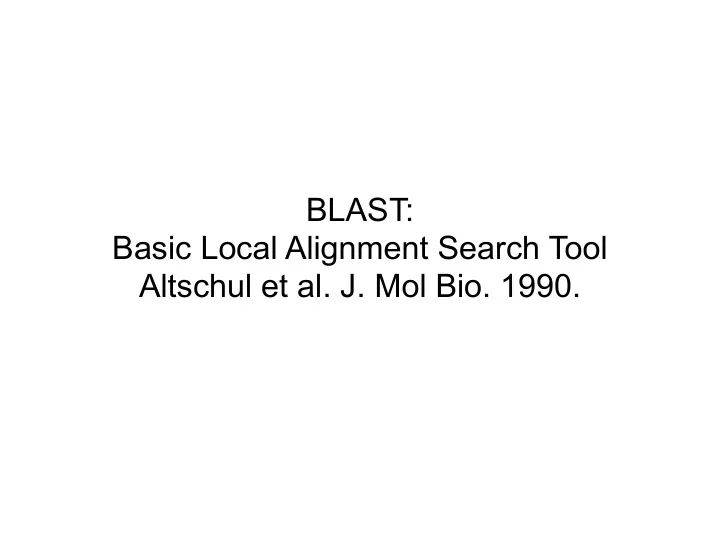

BLAST: Basic Local Alignment Search Tool Altschul et al. J. Mol Bio. 1990.
One of the highest cited papers in history
B asic L ocal A lignment S earch T ool
Why is database search difficult?
Consider a simpler problem p t Goal: Find all occurrences of a pattern in a text Input: Pattern p = p 1 … p n and text t = t 1 … t m Output: All positions 1< i < ( m – n + 1) such that the n - letter substring of t starting at i matches p Motivation : Searching database for a known pattern
Further simplified version p t p = ATC or AAA or TTC or … Text = Human genome (3 billion basepairs) Pattern = a 3-letter word Output: All positions 1< i < ( m – n + 1) such that the n -letter substring of t starting at i matches p
Key idea: preprocessing Preprocessing: store exact matches of all short patterns on the text {1,6,100,2000,5454, …, } ATC {15,21,30,785,3434, …, } AAA {5,164,220,502,943, …, } TTC …
Key idea: preprocessing Preprocessing: store exact matches of all short patterns on the text {1,6,100,2000,5454, …, } ATC {15,21,30,785,3434, …, } AAA {5,164,220,502,943, …, } TTC … what if n is big?
Hashing A hash function maps a key to a value
Hash table • Hash table is a data structure: a way to store key-value pairs, and a way to retrieve them • Based on the idea of a hash function. This maps a key or an object (e.g., a string, or a more complex record) to an integer, the “address” • The value of the key is then stored at that address in memory
Hashing: an example • Key: (AAACGTAT, 1234321) • i.e., a 8 bp-string and its location in genome • We want to store many such strings and their locations • and later retrieve all locations of a particular string really quickly • Hash function h(AAACGTAT) = 435 Key=String Value = Address of where Location(String) is stored
Hashing: an example • Let’s assume that there are 4 8 = 64K memory locations available. • The first time we see (AAACGTAT, *), we store it at address h(AAACGTAT) = 435. • The next time we see (AAACGTAT, *), we compute h(AAACGTAT), go to 435, find it already occupied. A collision!
How to handle collisions • Buckets: Address 435 can store multiple keys/ objects (e.g., as a linked list) • Linear probing: If an address is occupied, store the key/object in next available location • Multiple hashing: have an army of hash functions. If the first one (“h”) led to a collision, try another hash function (“h2”)
Bucketing and Chaining
Open addressing and linear probing
Preprocessing and hash Preprocessing: store exact matches of all short patterns on the text by a hash table h retrieve {1,6,100,2000,5454, …, } address1 ATC h retrieve {15,21,30,785,3434, …, } address2 AAA h retrieve {5,164,220,502,943, …, } address3 TTC
BLAST: finding maximal segment pairs • Given two sequences of same length, the similarity score of their alignment (without gaps) is the sum of similarity values for each pair of aligned residues • Maximal segment pair (MSP): Highest scoring pair of identical length segments from the two sequences being compared (“query” and “subject”) • The similarity score of an MSP is called the MSP score • BLAST heuristically aims to find them
Maximal segment pairs and High scoring pairs • Goal: report database sequences that have MSP score above some threshold S. • Thus, sequences with at least one locally maximal segment pair that scores above S.
A quick way to find MSPs • Homologous sequences tend to have very similar or even identical substrings, also called seeds. • From a seed, it is possible to construct a local HSP/MSP by extending to flanking regions. Extend Extend Seed
Efficient algorithm?
Recommend
More recommend